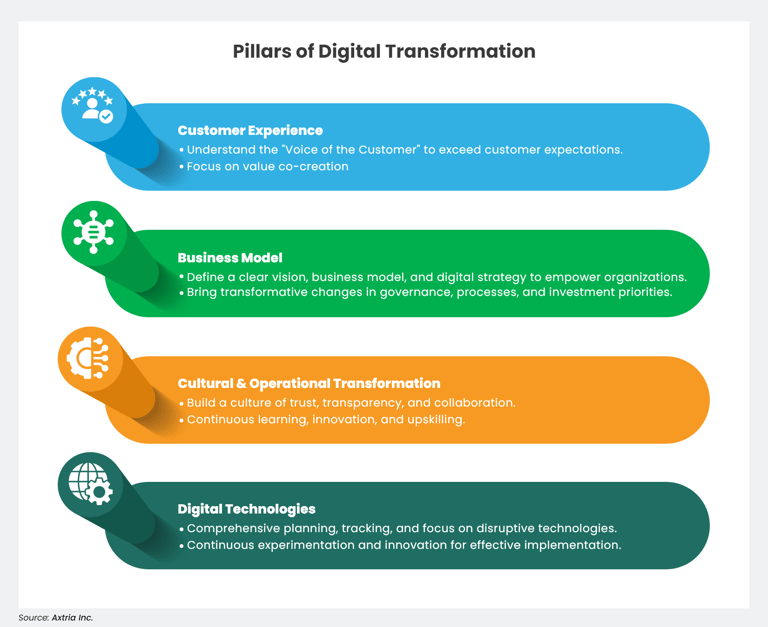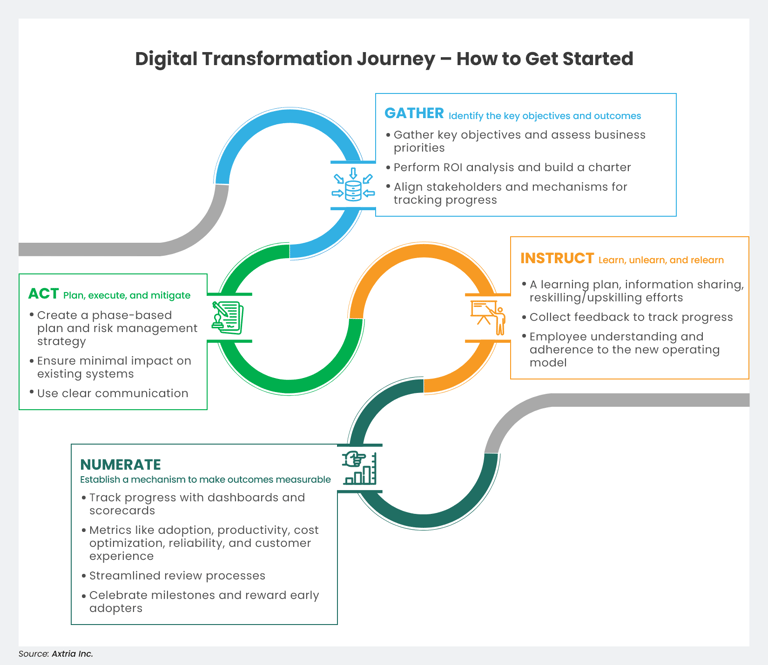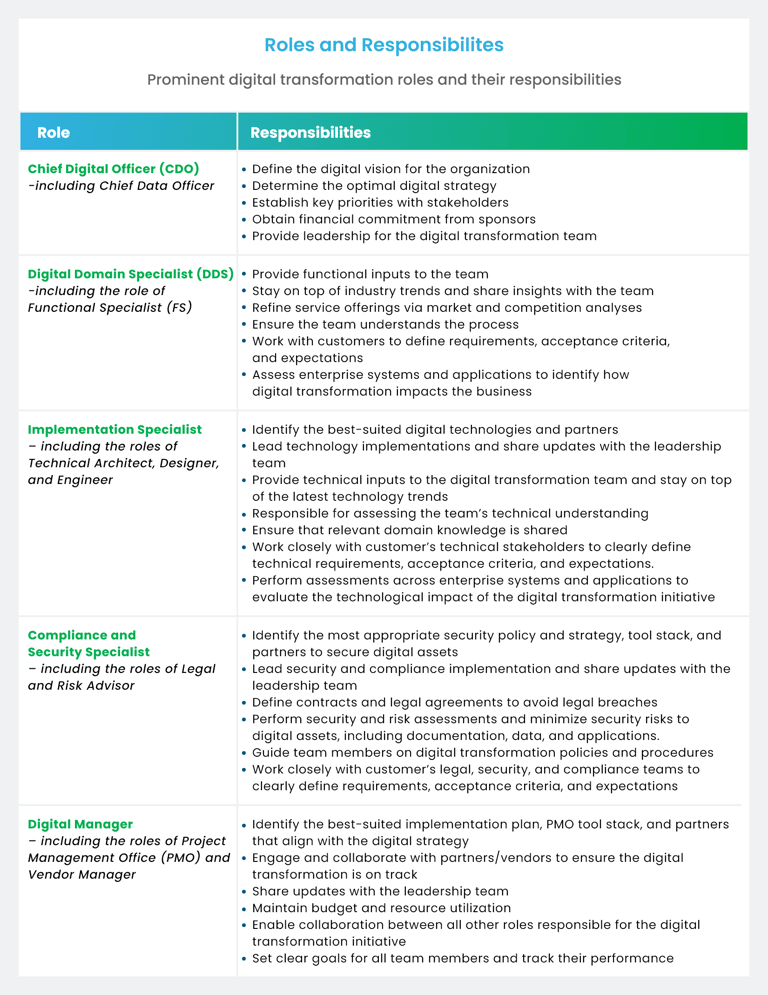Digital Transformation
Introduction
Since the beginning of the 21st century, we have seen many innovations, not only in technology but also in the processes and techniques that have redefined business operations and our personal interactions. Not a single business can deny the positive impact digital transformation has made on its growth and maturity.
Pharma companies envisioned how using the latest tools and techniques would reduce costs, improve market share, and improve healthcare provider experiences and patient outcomes. Many organizations started their digital transformation journeys in 2019 or had plans to begin in 2020, but the emergence of COVID-19 forced them to accelerate those plans. COVID-19 also created a sense of urgency around implementing disruptive ideas and innovations across the pharma and healthcare industries.
First, let’s understand digital transformation, why it is so important, and how it reshapes every interaction and enhances our lives.
What Is Digital Transformation?
Digital transformation is a holistic change across an organization’s assets – its people, processes, and technology. By leveraging digital technology, information, and communications systems, stakeholders experience enhanced value through continual improvement and innovations.
The Importance of Digital Transformation for a Business
Digital transformation is imperative for businesses today as it provides a strategy for surviving digital disruption by adjusting to the current way of working. Digital disruption refers to the ways competitors enhance their capabilities by leveraging the latest trends in technology and processes to provide a better experience to consumers.
For example, the continuing digital transformation of music and entertainment has seriously disrupted those industries. First, the storage medium evolved from analog recordings like vinyl records to digital files like MP3s. Now, the delivery method has transformed, too, with consumers opting for online streaming.
Let’s take an example from the pharma and healthcare industries. Consider the COVID-19 situation, which has resulted in major digital disruptions. Over the past few years, we have transitioned from almost exclusively face-to-face doctor visits to frequent on-demand phone/video consultations for common health issues, with face-to-face visits increasingly reserved for second-level visits. From lab testing to at-home testing, and in some cases, the administration of approved medication and at-home techniques to treat some health issues. All are possible through seamless integration and stakeholder adoption of digital technologies in our value delivery chain.
Below are the key areas of impact that make digital transformation highly critical to a business:
- Enhanced user experience through self-service
- Increased operational efficiency by improving team productivity and reducing human errors via automation
- Greater agility to experiment and meet ad hoc business requirements
- Accelerated innovation resulting in improved products and higher revenue
- Enhanced collaboration through streamlined communication
- Faster decision-making through ingenious insights
Areas of Digital Transformation
Below are the key focus areas, or pillars, of digital transformation:

-
Customer Experience
Today’s organizations are concerned with the “Voice of the Customer” and the value of looking at projects from the customer’s perspective. This perspective involves understanding customer preferences and refining products and services accordingly. In the current digital disruption, customers have information at their fingertips, enhancing their awareness and elevating their expectations of products and services. Integrating the “Voice of the Customer” into business operations requires a thorough understanding of customer preferences and the steps necessary to exceed their expectations.
-
Business Model
An organization must define its vision and business model within the current market landscape and the company’s digital strategy. This enables its products and services to compete effectively against even the biggest competitors and create the best possible customer experience. This shift requires a change in organizational governance, process definitions, and a reprioritization of commitment towards critical investments such as time, effort, and budget.
-
Cultural and Operational Transformation
They say culture eats strategy for breakfast.
To ensure an organization’s vision, business model, and digital strategy are adhered to, it is essential to define a culture of trust, transparency, and camaraderie. We must build an environment where continuous learning, collaboration, improvement, and innovation encompass all employees and partners. Companies must provide ample opportunities for reskilling and upskilling to those responsible for implementing the digital strategy. Leadership plays a vital role in setting the right expectations at all levels to ensure enterprise-wide strategic and operational transformation.
-
Digital Technologies
The most unpredictable part of digital transformation is the technology required, as it sees the most significant amount of disruption and requires extensive focus, robust planning, and meticulous tracking. An industry-leading technology and tool stack across three key categories is required: internet, cloud, and mobile. Breathtaking innovations and advances in networking, storage, and computing drive this.
Cloud-enabled digital transformation has already resulted in the cost-savings of millions of dollars across industries.
Continuous experimentation and innovation are a must for encouraging technology enablers who ensure an organization's effective implementation of digital transformation.
Digital Transformation Challenges and Pitfalls
A lot is at stake when an organization embarks on the digital transformation journey. The abundance of emerging digital technologies, rapidly-changing business priorities, and ever-changing consumer loyalties result in various unseen challenges.
Some of the biggest pitfalls are below:
Cultural: Quickly introducing too many disruptive changes which are not in sync with the organization’s culture is a common pitfall.
Organizational: Identifying new roles with a mix of multi-generational employees can result in different growth and upskilling expectations.
Operational: Sometimes, unrealistic expectations cause organizations or employees to take too many shortcuts and workarounds, resulting in lower quality.
Economical: Sometimes, due to a lack of proper due diligence, organizations try to reinvent the wheel. They do not leverage their existing assets and, as a result, experience a lower return on investment (ROI). In other cases, they may resist the up-front costs of purpose-made systems, mistakenly thinking they can create their own, less costly, system.
Data Paralysis: Reports often contain too much data to analyze without appropriate structures and objectives, resulting in inadequate analysis despite abundant data.
Adopting a well-defined and robust digital strategy will mitigate the challenges and pitfalls mentioned above.
Digital Transformation Journey – How to Get Started
Understanding the most critical milestones before embarking on the digital transformation journey is essential. The broad steps listed below will ensure a clear vision of what an organization can GAIN from the effort: Gather, Act, Instruct, and Numerate. These steps will ensure a smooth journey to a digital workplace.

GATHER: Identify the key objectives and outcomes
-
Assess your key business priorities to see how quickly you need to begin the digital transformation initiative.
-
Perform an ROI analysis to see what value will be generated for each enterprise application and system compared to the required investment of time and money. This analysis should include tangible and intangible benefits like cost-saving, higher sales, better productivity, and enhanced customer experience.
-
Build a digital transformation charter highlighting the information gathered from steps 1 and 2 above.
-
Ensure that key stakeholders and sponsors agree on this initiative and set clear expectations for outcomes and the support required.
-
Define methods and mechanisms to keep the organizational teams aligned with their objectives, and track the progress of outcomes.
ACT: Plan, execute, and mitigate
-
Create a detailed phase-based plan. The first phase should cover systems and applications that are essentially “quick wins,” requiring minimal effort and risk. This strategy will give confidence to team members and enable them to refine the project based on what they learned in the first phase.
-
Create a well-defined risk management plan where liabilities, mitigation, and contingency options are clearly explained. Be sure to leverage past experience to determine a robust risk management strategy. Continuous risk reassessment is also required to ensure prioritization and optimal resource planning.
-
The most important concern during the execution phase is to ensure minimal or no impact on the existing systems and applications while creating an optimal transition strategy for data, processes, and users.
-
Create a thorough communication plan to keep all internal and external stakeholders informed about critical decisions, progress, and changes in priorities during the digital transformation initiative.
INSTRUCT: Learn, unlearn, and relearn
-
Create a learning plan to ensure the employees understand and follow the new operating model established under the digital transformation initiative.
-
Information should be shared frequently with relevant teams to ensure adoption and adherence.
-
Monitor digital reskilling/upskilling closely and relay key objectives and transition-related messages through several internal channels like town halls, blogs, posters, and emails.
-
Collecting employee and partner feedback via surveys and creating a repository to track progress on the digital transformation initiative produces a valuable resource.
NUMERATE: Establish a mechanism to make outcomes measurable
-
Create simple but effective dashboards and balanced scorecards to track and monitor the progress of the digital transformation initiative.
-
The following are some of the critical categories for tracking and monitoring metrics to ensure the digital journey is on track:
-
Adoption and Adherence of the Digital Ecosystem
-
Team Productivity
-
Cost Optimization
-
Reliability and Availability of Products and Services
-
Customer Experience
-
-
Establish a streamlined review and approval mechanism for all milestones in the plan.
-
Share and celebrate the achievement of milestones to encourage employees and partners to adopt new tools, practices, and processes faster. Reward and recognize early adopters to keep their motivation level high and ensure high adherence in the long-term.
Digital Transformation Roles and Responsibilities
Digital transformation has introduced new job functions and roles like Chief Digital Officer (CDO), Chief Data Officer, and Digital Transformation Manager, which were unheard of a few years ago. The creation of these roles aims to ensure the right priorities and focus on upskilling, learning, and consolidating past experiences to effectively manage digital disruption and adopt digital transformation across any organization.
Below are some of the most prominent digital transformation roles and their responsibilities. Most of these are offshoots or extensions of existing roles; however, each has a distinct purpose and requires unique positioning within the organization.

In addition to these roles, the corporate support teams, HR, Marketing, Admin, Finance, Learning and Development, and others, also need to transition into new roles more aligned with the digital transformation strategy. This will ensure effective alignment, coordination, and collaboration between all organizational stakeholders, leading to the successful organization-wide implementation of digital transformation initiatives.
Digital Transformation Trends
Digital transformation has been around for decades, but because of the current rapid pace of disruption throughout the business world, we have started talking about it more.
Throughout history, various trends have revolutionized the way businesses operate, changing the mindset of employees and consumers. Some examples include the introduction of computer-aided design in manufacturing during the 1970s, the launch of enterprise resource planning tools in the 1980s, and the introduction of customer relationship management tools in the 1990s. And just before the start of the 21st century, the introduction of e-commerce, further boosted by the launch of social media platforms in the 2000s, revolutionized the way we collaborate.
The next obvious step was to bring everything together and focus on one true picture of the end consumer. Recent trends in digital transformation have focused on hybrid work, artificial intelligence/machine learning (AI/ML), intelligent search, customer data platforms, integrated development and operations, agile software development practices, and information technology service management platforms. Together with future trends, these will continue to expand our limits and ensure faster, smoother, and better outcomes.
The Role of AI in Digital Transformation
In the adoption of digital technologies, AI plays a vital role. Digital transformation initiatives depend on a robust understanding of customers, employees, and other stakeholders. AI-based applications and systems continually learn from the available data and identify ways to enhance the customer experience by generating better value.
The most significant benefits of AI are greater efficiency and scalability, which enable faster and more accurate decision-making in critical situations. But to make this happen, we must start by defining the appropriate data inputs and analytical methods. In short, the better the historical data, the better the quality of the predictions. For example, pharma companies use AI to better understand health systems, physicians, and patients by leveraging available data and making accurate predictions about the competitive landscape and industry trends. This helps improve employee productivity, customer loyalty, and partner collaboration, resulting in higher sales and improved market value in the future.
COVID-19: A Real-life Example of Digital Transformation
The COVID-19 pandemic changed our priorities in ways we never imagined, altering our approach toward managing our work, as well as our personal health and fitness. It would not be an exaggeration to say the pandemic was the ultimate driver of an urgent digital transformation across the globe.
In their search for a vaccine, pharma companies collaborated with educational and research institutions in novel ways that changed the world. This revolutionary approach required a disruptive thought process from all stakeholders, from sponsors, researchers, and manufacturers, to hospitals, physicians, payers, governments, and others in the healthcare ecosystem.
Researching and developing effective vaccines within just a few months would have been impossible without the latest technology stack. Digital technologies like cloud computing, big data, AI/ML, and real-time analytics allowed our scientists and researchers to try thousands of combinations and identify the most effective one.
The next step was to conduct clinical trials at hundreds of sites across many countries while leveraging real-time predictive models that used COVID data from across the globe. Digital innovation yielded faster quality checks, allowed trial optimization, and analyzed vast amounts of data from those trials.
Next, pharma companies leveraged best-in-class digital technologies to ensure faster and higher-quality manufacturing and supply operations so vaccines could reach patients faster. Real-time dashboards tracked manufacturing and supply chains, while augmented reality helped diagnose and repair equipment. The interconnectivity of Internet of Things devices helped track vaccine inventories and ensured they were maintained at the optimal temperature. More than this, performing all these activities was challenging when most stakeholders were working remotely under strict travel and work restrictions. This is where the digital ecosystem of online communication and collaboration technologies came into play. According to a report by McKinsey, “A new survey finds that responses to COVID-19 have speeded the adoption of digital technologies by several years—and that many of these changes could be here for the long haul.”1
Digital Transformation in Pharma and Healthcare
Pharma and healthcare organizations have objectives in common, like enhanced patient outcomes, improved transparency and compliance, cost-saving, and better quality. All of these are accomplished more effectively through digital transformation.
Partnerships with vendors, prescribers, and payers are just a few examples of relationships that can be better managed using digital technologies. In fact, the right digital strategy can result in streamlined workflows, which can be easily understood and adhered to by all stakeholders.
Today, patients can easily access digital channels through their mobile devices and look up medical information about diagnoses, treatments, and procedures within seconds. This kind of digital access requires robust online patient engagement platforms which provide accurate details on therapeutic areas and drugs. It also provides pharma companies with a real-time feedback channel for new ideas and suggestions. Digital marketing is an important area that can reach more customers and improve brand recall, conversions, and sales.
Most pharma and healthcare organizations have either developed their own apps or are leveraging industry-leading fitness and health apps for promotion and real-time insights about the efficacy of their products and services. Digital technologies are helping pharma and healthcare data vendors improve their platforms and processes leading to faster and more efficient discovery, development, and delivery of drugs, medical equipment, and healthcare services.
Conclusion and Takeaways
Companies must plan, execute, and measure their digital transformation journey. And like any other journey, this one requires focusing on strengths, becoming lean, unlearning, relearning, and above all, keeping all options open. Every organization has a unique past and future, so there will be unknown challenges, but with genuine intent and enough knowledge, solutions will emerge. If all stakeholders persevere and remain resilient, the rewards will be great.
Digital disruption will continue to knock on our doors. We need to be on our toes and embark on our own digital transformation journeys today to future-proof our business and stay ahead of the competition.
This article is contributed by Avneet Bhatia, Senior Director at Axtria.
References
- Laura LaBerge, Clayton O’Toole, Jeremy Schneider, Kate Smaje. How COVID-19 has pushed companies over the technology tipping point—and transformed business forever [Internet]. New York: McKinsey & Company; 2020 October 05; [cited 2023 April 12]. Available from: https://www.mckinsey.com/capabilities/strategy-and-corporate-finance/our-insights/how-covid-19-has-pushed-companies-over-the-technology-tipping-point-and-transformed-business-forever
Table of Contents
- Introduction
- What Is Digital Transformation?
- The Importance of Digital Transformation for a Business
- Areas of Digital Transformation
- Digital Transformation Challenges and Pitfalls
- Digital Transformation Journey – How to Get Started
- Digital Transformation Roles and Responsibilities
- Digital Transformation Trends
- The Role of AI in Digital Transformation
- COVID-19: A Real-life Example of Digital Transformation
- Digital Transformation in Pharma and Healthcare
- Conclusion and Takeaways



